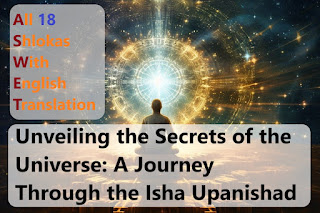The Formation of the Solar System | Nebular Hypothesis | Nebular Theory | Solar System Formation | Brihadaranyaka Upanishad
# Watch https://youtu.be/2YQKkJWM0WU
Dear readers,
Welcome back to our BLOG. Today, I will continue explaining the third shloka of the second Brahmana within the first chapter of the Brihadaranyaka Upanishad.
You can read the previous article to recite, know the translation, and understand the initial interpretation of the shloka.
Before we interpret further, I recommend you read the previous articles on the origin of the Universe, cosmic meditation, and introduction to the Brihadaranyaka Upanishad. You can also read the series on the Isha Upanishad to unveil the Secrets of Self if you missed it. Links to those articles are given at the bottom.
In the previous article, we learned that Viraj was the cosmic baby born from the cosmic embryo Hiranyagarbha. Here, Viraj is considered a living cosmic baby by the Rishi. Viraj further divided the body in three ways: the sun, the air, and Viraj itself as fire. Then, we meditated on the different body parts of Viraj. Essentially, Viraj is none other than our Universe. Through Viraj, we can see the interconnectedness of universe. All planets, moons, stars, and even us are working as a single body, and we are all interconnected. Hiranyagarbha is the manifestation of Brahman. As Viraj is born from Hiranyagarbha, Viraj is also a manifestation of the same Brahman. Even the Sun, air, and fire are manifestations of Brahman and represent the Prana or vital energy. The Sun is the source of energy; without the Sun, life cannot flourish on Earth. Fire is the digestive fire that transforms solar energy into other forms of energy in the body. Air is essential for breathing and life.
Now let's see another aspect. If you observe carefully, you will find different events that can be related to scientific hypotheses available today. We already discussed the Big Bang theory in the episode on the origin of the Universe. In this shloka, the Sun and the air were created from Viraj's body. We meditated on Earth as Viraj's breast. Long story short, I can see the formation of the Solar System in this shloka. Let us now understand the scientific model which can explain this event more accurately.
The most widely accepted scientific theory for the formation of the solar system is the Nebular Hypothesis. This theory suggests that the solar system formed approximately 4.6 billion years ago from a giant molecular cloud of gas and dust, known as the solar nebula. Here’s a step-by-step outline of the process according to this theory:
1. Collapse of the Solar Nebula: A nearby supernova or other event caused a disturbance in the solar nebula, leading to its gravitational collapse. As it collapsed, the cloud began to spin and flatten into a rotating disk.
2. Formation of the Protostar: Most of the material in the nebula was pulled toward the center to form the protostar, which eventually became the Sun. As the material accumulated, it heated up due to gravitational compression, and nuclear fusion reactions began, leading to the birth of the Sun.
3. Formation of Planetesimals: In the surrounding disk, particles of dust and ice collided and stuck together, forming larger and larger bodies called planetesimals. These planetesimals ranged from a few kilometers to hundreds of kilometers in diameter.
4. Accretion of Protoplanets: Through a process called accretion, planetesimals continued to collide and merge, gradually forming larger bodies known as protoplanets. These protoplanets eventually became the planets, moons, and other objects in the solar system.
5. Clearing of the Solar Nebula: The young Sun's strong solar wind blew away the remaining gas and dust in the disk, leaving behind the planets, moons, asteroids, and comets.
6. Differentiation and Cooling: The planets underwent a process of differentiation, where heavier elements sank to the center and lighter elements rose to the surface. Over time, the planets cooled and developed stable crusts and atmospheres.
The Nebular Hypothesis is supported by several lines of evidence, including:
1. The observation that most planets orbit the Sun in the same direction and in roughly the same plane.
2. The presence of a protoplanetary disk around young stars observed in other parts of the galaxy.
3. The composition and distribution of materials in the solar system, such as the rocky inner planets and gas giant outer planets.
This theory provides a comprehensive explanation for the formation and structure of the solar system, and it continues to be refined as new observational data and theoretical models become available.
In conclusion, as truth seekers, we need to be open to all hypotheses and choose the one supported by the most evidence. However, we must respect all the founders of these hypotheses because they tried to answer based on the available knowledge of their time. Their tireless efforts bring us closer to the truth. So, be respectful but evidence-based and scientific. Philosophically, understand that we are not separate. We are part of this vast Universe. We are tiny in comparison to the Universe. So, set aside ego, embrace the truth, and play your role in coordination with others, just as the cosmic bodies play their roles. We should act as one Earth rather than being divided by nations.
Follow us on
Youtube: https://www.youtube.com/@universalvedanta
Koo App: @universal.vedanta (https://www.kooapp.com/profile/universal.vedanta )
WhatsApp: https://whatsapp.com/channel/0029Va5D8cn5PO12m5EbE42y
Learn Meditation on Viraj | Meditation on International Yoga Day | Dhyan | Brihadaranyaka Upanishad
https://universal-vedanta.blogspot.com/2024/06/learn-meditation-on-viraj-meditation-on.html
Origin of The Universe | What Was The Big Bang? | The Hindu Interpretation of Creation
https://universal-vedanta.blogspot.com/2024/05/origin-of-universe-what-was-big-bang.html
Brihadaranyaka Upanishad - 20 Minute Guided Meditation | Cosmic Meditation
https://universal-vedanta.blogspot.com/2024/04/20-minute-guided-meditation-cosmic.html
https://universal-vedanta.blogspot.com/2024/03/brihadaranyaka-upanishad-chapter-1-1st-brahmana-cosmic-meditation.html
https://universal-vedanta.blogspot.com/2024/02/the-universe-is-infinite-you-are-too.html
https://universal-vedanta.blogspot.com/2024/02/isha-upanishad-explained-in-english.html
https://universal-vedanta.blogspot.com/2023/02/isha-upanishad-shloka-8-english-does.html
https://universal-vedanta.blogspot.com/2023/01/isha-upanishad-shloka-07-english-reason.html
https://universal-vedanta.blogspot.com/2023/01/isha-upanishad-shloka-06-english-hate.html
https://universal-vedanta.blogspot.com/2022/12/isha-upanishad-shloka-05-english-know.html
Isha Upanishad - Shloka - 04
https://universal-vedanta.blogspot.com/2022/12/isha-upanishad-shloka-04-english.html
Isha Upanishad - Shloka - 03
https://universal-vedanta.blogspot.com/2022/11/isha-upanishad-shloka-03-how-to-stop-killing-self.html
Isha Upanishad - Shloka - 02
https://universal-vedanta.blogspot.com/2022/10/isha-upanishad-shloka-02-how-to-live-100-years.html
Isha Upanishad - Shloka - 01
https://universal-vedanta.blogspot.com/2022/09/universal-vedanta-rishyashish-isha-upanishad-verse-01.html
Introduction to Isha Upanishad
https://universal-vedanta.blogspot.com/2022/08/universal-vedanta-rishyashish-isha-upanishad.html




Comments
Post a Comment